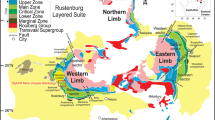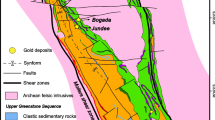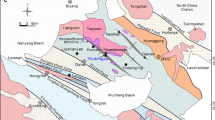Abstract
The Noril’sk mining district is located at the northwest margin of the Tunguska basin, in the centre of the 3,000×4,000 km Siberian continental flood basalt (CFB) province. This CFB province was formed at the Permo-Triassic boundary from a superplume that ascended into the geometric centre of the Laurasian continent, which was surrounded by subducting slabs of oceanic crust. We suggest that these slabs could have reached the core–mantle boundary, and they may have controlled the geometric focus of the superplume. The resulting voluminous magma intruded and erupted in continental rifts and related extensive flood basalt events over a 2–4 Ma period. Cu–Ni–PGE sulfide mineralization is found in olivine-bearing differentiated mafic intrusions beneath the flood basalts at the northwestern margin of the Siberian craton and also in the Taimyr Peninsula, some 300 km east of a triple junction of continental rifts, now buried beneath the Mesozoic–Cenozoic sedimentary basin of western Siberia. The Noril’sk-I and Talnakh-Oktyabr’sky deposits occur in the Noril’sk–Kharaelakh trough of the Tunguska CFB basin. The Cu–Ni–PGE-bearing mineralized intrusions are 2–3 km-wide and 20 km-long differentiated chonoliths. Previous studies suggested that parts of the magma remained in intermediate-level crustal chambers where sulfide saturation and accumulation took place before emplacement. The 5–7-km-thick Neoproterozoic to Palaeozoic country rocks, containing sedimentary Cu mineralization and evaporites, may have contributed additional metal and sulfur to this magma. Classic tectonomagmatic models for these deposits proposed that subvertical crustal faults, such as the northeast-trending Noril’sk–Kharaelakh fault, were major trough-parallel conduits providing access for magmas to the final chambers. However, geological maps of the Noril’sk region show that the Noril’sk–Kharaelakh fault offsets the mineralization, which was deformed into folds and offset by related reverse faults, indicating compressional deformation after mineralization in the Late Triassic to Early Jurassic. In addition, most of the intrusions are sills, not dykes as should be expected if the vertical faults were major conduits. A revised tectonic model for the Noril’sk region takes into account the fold structure and sill morphology of the dominant intrusions, indicating a lateral rather than vertical emplacement direction for the magma into final chambers. Taking into account the fold structure of the country rocks, the present distribution of the differentiated intrusions hosting the Noril’sk-I and Talnakh–Oktyabr’sky deposits may represent the remnants of a single, >60 km long, deformed and eroded palm-shaped cluster of mineralized intrusions, which are perceived as separate intrusions at the present erosional level. The original direction of sill emplacement may have been controlled by a northeast-trending paleo-rise, which we suggest is present at the southeastern border of the Noril’sk–Kharaelakh trough based on analysis of the unconformity at the base of the CFB. The mineralized intrusions extend along this rise, which we interpret as a structure that formed above the extensionally tilted block in the metamorphic basement. Geophysical data indicate the presence of an intermediate magma chamber that could be linked with the Talnakh intrusion. In turn, this T-shaped flat chamber may link with the Yenisei–Khatanga rift along the northwest-trending Pyasina transform fault, which may have served as the principal magma conduit to the intermediate chamber. It then produced the differentiated mineralized intrusions that melted through the evaporites with in situ precipitation of massive, disseminated, and copper sulfide ore. The Noril’sk–Kharaelakh crustal fault may not relate to mineralization and possibly formed in response to late Mesozoic spreading in the Arctic Ocean.










Similar content being viewed by others
References
Anonymous (2002) Noril’sk to keep output steady. Min J 339(8692):12–13
Arndt N, Lehnert K, Vasil’ev Y (1995) Meimechites: high magnesian lithosphere-contaminated alkaline magmas from deep subcontinental mantle. Lithos 34:41–59
Bogdanov NA, Khain VE, Rozen OM, Shipilov EV, Vernikovskiy VA, Drachev SS, Kostyuchenko SL, Kuzmichev AB, Sekretov SB (1998) Explanatory note and tectonic map of the Kara and Laptevs Sea (1:2,500,000). Institute of Lithosphere RAS, Moscow
Campbell IH, Czamanske GK, Fedorenko VA, Hill RI, Stepanov V (1992) Synchronism of the Siberian traps and the Permian–Triassic boundary. Science 258:1760–1763
Courtillot V, Jaupart C, Manighetti I, Tapponier P, Besse J (1999) On causal links between flood basalts and continental breakup. Earth Planet Sci Lett 166:177–195
Czamanske GK, Dalrymple GB, Lind EN, Kropotov SV, Fedorenko VA, Wooden JL, Walker RJ (1993) The Siberian plume – additional constraints. EOS 74:555.
Czamanske GK, Wooden JL, Zientek ML, Fedorenko VA, Zen’ko TE, Kent J, King B-SW, Knight RJ, Siems DF (1994) Geochemical and isotopic constraints on the petrogenesis of the Noril’sk–Talnakh ore-forming system. In: Lightfoot PC, Naldrett AJ (eds) Proc Sudbury–Noril’sk Symposium, Ontario Geol Surv Spec Pap 5, pp 313–341
Diakov S, West R, Schissel D, Krivtsov A, Kochnev-Pervukhov V, Migachev I (2002) Recent advances in the Noril’sk model and its application for exploration of Ni–Cu–PGE sulfide deposits. In: Goldfarb RJ, Nielsen RL (eds) Integrated methods for discovery: global exploration in the twenty-first century. SEG Spec Publ 9, pp 203–226
Distler VV (1994) Platinum mineralization of the Noril’sk deposits. In: Lightfoot PC, Naldrett AJ (eds) Proc Sudbury–Noril’sk Symposium, Ontario Geol Surv Sped Pap 5, pp 243–260
Dobretsov NL (1997) Permian–Triassic magmatism and sedimentation in Eurasia as a result of a superplume (in Russian). Dokl Russ Acad Sci 354:220–223
Dobretsov NL, Vernikovsky VA (2001) Mantle plumes and their geologic manifestation. Int Geol Rev 43:771–787
Dodin DA, Chernyshov NM, Yatskevich BA (2000) Platinum deposits of Russia. Nauka, St Petersburg (in Russian)
Duzhikov OA, Distler VV, Strunin BM, Sherman ML, Sluzhenikin SF (1992) Copper–nickel sulfide ore-bearing formations: geology and metallogeny of sulfide deposits, Noril’sk region, USSR. SEG Spec Publ 1, pp 61–146
Fedorenko VA (1981). Petrochemical series of the Noril’sk effusive rocks (in Russian). Geol Geofiz 6:78–88
Fedorenko VA (1994) Evolution of magmatism as reflected in the volcanic sequence of the Noril’sk region. In: Lightfoot PC, Naldrett AJ (eds) Proc Sudbury–Noril’sk Symposium, Ontario Geol Surv Spec Pap 5, pp 171–184
Genkin AD, Distler VV, Gladyshev GD, Filimonova AA, Yevstigneeva TL, Kovalenker VA, Laputina IP, Smirnov AV, Grokhovskaya TL (1981). Sulfide copper–nickel ores of the Noril’sk deposits, Moscow, Nauka (in Russian)
Grinenko LN (1986) Sulfur sources for basic–ultrabasic rocks and associated copper–nickel ores (in Russian). Dr Sci Diss, Vernadsky Institute of Geochemistry, Moscow
Hawkesworth CJ, Lightfoot PC, Fedorenko VA, Blake S, Naldrett AJ, Doherty W, Gorbachev NS (1995) Magma differentiation and mineralization in the Siberian continental flood basalts. Lithos 34:61–88
Kazakov AM (1995) Early Mesozoic stratigraphy and sedimentogenesis of oil-bearing basins of Siberia (in Russian). Dr Sci Diss, SNIIGGiMS, Novosibirsk
Khain VE, Kravchenko SM (1999) Structure of the subcontinental mantle convection and forecast for giant deposits of Tomtor (REE–Nb–P) and Noril’sk (Cu–Ni–Pt) types (in Russian). Vestnik Moskovskogo Universiteta, Ser 4, Geol 6:3–9
Khakhaev BN, Kaplun VA (1995) Results of drilling and investigations of the Tyumen superdeep well. Abstracts 21–23 February 1995, Perm, KamNIIKIGS (in Russian)
Kontorovich AE (ed) (1994) Oil and gas-bearing basins and regions of Siberia. Vol 2. West Siberian Basin. OIGGM SO RAN, Novosibirsk (in Russian)
Kunilov VY (1994) Geology of the Noril’sk region: the history of the discovery, prospecting, exploration and mining of the Noril’sk deposits. In: Lightfoot PC, Naldrett AJ (eds) Proc Sudbury–Noril’sk Symposium, Ontario Geol Surv Spec Pap 5, pp 203–216
Larson RL (1991) Latest pulse of Earth: evidence for a mid-Cretaceous superplume. Geology 19:547–550
Lightfoot PC, Hawkesworth CJ (1997). Flood basalts and magmatic Ni, Cu, and PGE sulfide mineralization: comparative geochemistry of the Noril’sk (Siberian traps) and West Greenland sequences. In: Mahoney JJ, Coffin MF (eds) Large igneous provinces: continental, oceanic, and planetary flood volcanism, Washington, Am Geophys Union, Geophys Monogr Ser 100
Lightfoot PC, Naldrett AJ (eds) (1994). Proceedings of the Sudbury–Noril’sk Symposium. Ontario Geol Surv Spec Pap 5
Lightfoot PC, Naldrett AJ, Gorbachev NS, Doherty W, Fedorenko VA (1990) Geochemistry of the Siberian Trap of the Noril’sk area, USSR, with implications for the relative contributions of crust and mantle to flood basalt magmatism. Contrib Mineral Petrol 104:631–644
Lightfoot PC, Hawkesworth CJ, Hergt J, Naldrett AJ, Gorbachev NS, Fedorenko VA, Doherty W (1993). Remobilization of the continental lithosphere by mantle plumes: major, trace element, and Sr-, Nd-, and Pb-isotope evidence from picritic and tholeiitic lavas of the Noril’sk District, Siberian Trap, Russia. Contrib Mineral Petrol 114(2):171–188
Lightfoot PC, Naldrett AJ, Gorbachev NS, Fedorenko VA, Hawkesworth CJ, Hergt J, Doherty W (1994) Chemostratigraphy of Siberian Trap lavas, Noril’sk District: implications for the source of flood basalt magmas and their associated Ni–Cu mineralization. In: Lightfoot PC, Naldrett AJ (eds) Proc Sudbury–Noril’sk Symposium, Ontario Geol Surv Spec Pap 5, pp 283–312
Likhachev AP (1994) Ore-bearing intrusions of the Noril’sk region. In: Lightfoot PC, Naldrett AJ (eds), Proc Sudbury–Noril’sk Symposium, Ontario Geol Surv Spec Pap 5, pp 185–201
Likhachev AP (1996). About dynamics of the formation of Talnakh ore-bearing intrusion and related Pt–Cu–Ni deposits (in Russian). Otechestvennaya Geologiya 8:20–26
Lozovsky VR, Esaulova NK (eds) (1998) Permian–Triassic boundary in the continental series of Eastern Europe. Moscow, GEOS (in Russian)
Milanovskiy EE (1996) Geology of Russia and adjacent countries. Moscow University Press (in Russian)
Naldrett AJ, Lightfoot PC (1994) Ni–Cu–PGE ore of the Noril’sk region, Siberia: a model for giant magmatic sulfide deposits associated with flood basalts. SEG Spec Publ 2, pp 85–123
Naldrett AJ, Lightfoot PC, Fedorenko VA, Doherty W, Gorbachev NS (1992) Geology and geochemistry of intrusions and flood basalt of the Noril’sk region, USSR, with implication for the origin of the Ni–Cu ores. Econ Geol 87:975–1004
Naldrett AJ, Asif M, Gorbachev NS, Kunilov VY, Stekhin AI, Fedorenko VA, Lightfoot PC (1994) The composition of the Ni–Cu ores of the Oktyabr’sky deposit, Noril’sk region. In: Lightfoot PC, Naldrett AJ (eds) Proc Sudbury–Noril’sk Symposium, Ontario Geol Surv Spec Pap 5, pp 357–371
Naldrett AJ, Fedorenko VA, Asif M, Lin S, Kunilov VE, Stekhin AI, Lightfoot PC, Gorbachev NS (1996) Controls on the composition of Ni–Cu sulfide deposits as illustrated by those at Noril’sk, Siberia. Econ Geol 91:751–773
Naldrett AJ, Fedorenko VA, Lightfoot PC, Gorbachev NS, Doherty W, Asif M, Lin S, Johan Z (1998) A model for the formation of the Ni–Cu–PGE deposits of the Noril’sk region. In: Laverov NP, Distler VV (eds) International platinum. Theophrastus Publication, St Petersburg, pp 92–106
Nikishin AM, Yakubchuk AS (2002) Model of global tectonics: lithospheric plates and plumes interactions (in Russian). Bull Mosk Obsh Ispyt Prir Otd Geol 2:3–18
Nikishin AM, Ziegler PA (1999) Intraplate tectonics and magmatism at the Permian/Triassic transition as a reaction to a global reorganization of plate kinematics and unstable mantle dynamics. Tectonics, geodynamics and the processes of magmatism and metamorphism (in Russian). Conf Proc 2, GEOS, Moscow, pp 39–42
Nikishin AM, Ziegler P, Abbott D, Brunet M-F, Cloetingh S (2002) Permo-Triassic intraplate magmatism and rifting in Eurasia: implications for mantle plumes and mantle dynamics. Tectonophysics 351:3–39
Rempel GG (1994). Regional geophysics at Noril’sk. In: Lightfoot PC, Naldrett AJ (eds) Proc Sudbury–Noril’sk Symposium, Ontario Geol Surv Spec Pap 5, 147–160
Renne P, Zichao Z, Richards MA, Black MT, Basu A (1995) Synchrony and causal relations between Permian–Triassic boundary crisis and Siberian flood volcanism. Science 269:1413–1415
Ryabov VV, Zolotukhin VV (1977) Minerals of differentiated traps. Nauka, Novosibirsk (in Russian)
Schissel DJ, Smail R (2001) Deep mantle plumes and ore deposits. In: Ernst RE, Buchan KL (eds) Mantle plumes: their identification through time. Geol Soc Am Spec Pap 352, Boulder, Colorado, pp 291–321
Scotese CR, McKerrow WS (1990) Revised world maps and introduction. In: McKerrow WS, Scotese CR (eds) Palaeozoic palaeogeography and biogeography. Geol Soc Lond Mem 12, pp 1–21
Sherman ML (ed) (1991) Geological map of Noril’sk region. Scale 1:200,000. Krasnoyarskgeologiya, VSEGEI, 4 sheets
Shipilov EV, Tarasov GA (1998) Regional geology of oil and gas bearing sedimentary basins of the Russian West-Arctic shelf. Kola Science Centre RAS, Apatity (in Russian)
Simonov ON, Lul’ko VA, Amosov YN, Salov VM (1994) Geological structure of the Noril’sk region. In: Lightfoot PC, Naldrett AJ (eds) Proc Sudbury–Noril’sk Symposium, Ontario Geol Surv Spec Pap 5, pp 161–170
Sluzhenikin SF, Distler VV, Duzhikov OA (1994) Low-sulfide platinum mineralization in Noril’sk differentiated intrusions (in Russian). Geologiya Rudnykh Mestorozhdeniy 36(3):195–217
Smethurst MA, Khramov AN, Torsvik TH (1998) The Neoproterozoic and Palaeozoic palaeomagnetic data for the Siberian Platform: from Rodinia to Pangea. Earth Sci Rev 43(1–2):1–24
Sobolev VS (ed) (1978) Exploration criteria for sulfide ores of the Noril’sk type. Nauka, Novosibirsk, pp 66 – 86 (in Russian)
Stekhin AI (1994) Mineralogical and chemical characteristics of the Cu–Ni- ores of the Oktyabr’sky and Talnakh deposits. In: Lightfoot PC, Naldrett AJ (eds) Proc Sudbury–Noril’sk Symposium, Ontario Geol Surv Spec Pap 5, pp 217–230
Su W, Woodward RL, Dziewonski AM (1994) Degree 12 model of shear velocity heterogeneity in the mantle. J Geophys Res 99:6945–6980
Surkov VS (ed) (1995) Atlas of paleotectonic and paleogeological-landscape maps of hydrocarbon provinces of Siberia. SNIIGGIMS, Petroconsultants, Novosibirsk
Surkov VS, Zhero OG (1981) The basement and the platform cover of the West Siberia basin development. Nedra, Moscow (in Russian)
Torgashin AS (1994) Geology of the massive and copper ores from the western part of the Oktyabr’sky deposit. In: Lightfoot PC, Naldrett AJ (eds) Proc Sudbury–Noril’sk Symposium, Ontario Geol Surv Spec Pap 5, pp 231–241
Veevers JJ (1995) Emergent, long-lived Gondwanaland vs. submergent, short-lived Laurasia: supercontinental and Pan-African heat impacts long-term buoyancy by mafic underplating. Geology 23:1131–1134
Veevers JJ, Tewari RC (1995) Permian–Carboniferous and Permian–Triassic magmatism in the rift zone bordering the Tethyan margin of southern Pangea. Geology 23:467–470
Westphal M, Gurevich EL, Samsonov BV, Feinberg H, Pozzi J-P, Khramov AN (1997) How long lasted the eruption of Siberian Flood Basalts? In: EUG 9, 23–27 March 1997, Strasbourg (France). Abstracts, p 524
White R, McKenzie D (1989) Magmatism at rift zones: the generation of volcanic continental margins and flood basalts. J Geophys Res 100:17543–17585
Yakubchuk A, Edwards A, Diakov S, Kirwin D (2002) Siberia and Mongolia: how they are linked, and their role in Asian mineral potential. Mineral Potential of Asia, MMAJ Forum, Vancouver, January 2002, MMAJ, pp 7–8
Yapaskurt OV (1992). Lithogenesis and mineral resources of miogeosynclines. Nedra, Moscow (in Russian)
Zen’ko TE, Czamanske GK (1994) Spatial and petrologic aspects of the intrusions of the Noril’sk and Talnakh ore junctions. In: Lightfoot PC, Naldrett AJ (eds) Proc Sudbury–Noril’sk Symposium, Ontario Geol Surv Spec Pap 5, pp 263–281
Ziegler PA (1990) Geological atlas of Western and Central Europe. Shell International Petroleum Mij BV, distributed by Geol Soc London Publishing House, Bath
Zolotukhin VV, Almukhamedov AI (1991) Basalts of the Siberian platform: occurrence, composition, mechanism of formation (in Russian). In: Polyakov GV (ed) Traps of Siberia and Deccan: similarities and differences. Novosibirsk, Nauka, pp 7–39
Zolotukhin VV, Vilensky AM, Vasiliev YR (1984) Magnesium mafic rocks from the west of the Siberian Platform and problems of nickel potential. Nauka, Novosibirsk (in Russian)
Zolotukhin VV, Vasiliev YR, Duzhikov OA (1989) Trap diversity and source of magma. Nauka, Novosibirsk (in Russian)
Zonenshain LP, Kuzmin MI, Natapov LM (1990) Geology of the USSR: a plate tectonic synthesis. In: Page BM (ed) Am Geophys Union, Washington, DC, pp 17–26
Acknowledgements
We thank Sergei Diakov, Don Schissel, Peter Ziegler, Dallas Abbott and Chris Stanley for discussions. We specially thank Jeff Hedenquist for useful comments and Noel White for very helpful critical comments and arguments. Alexander Yakubchuk benefited from discussions with Alexander Stekhin and Oleg Oleshkevich, who worked extensively in Noril’sk and were excellent guides to its mines. We thank BHP-Billiton World Exploration Inc for permission to publish parts of the research results discussed in this paper. The reviews by Nick Arndt and Peter Lightfoot helped to improve and defend our arguments. We also thank Bernd Lehmann who encouraged us to write this paper.
Author information
Authors and Affiliations
Corresponding author
Additional information
Editorial handling: P. Lightfoot
Rights and permissions
About this article
Cite this article
Yakubchuk, A., Nikishin, A. Noril’sk–Talnakh Cu–Ni–PGE deposits: a revised tectonic model. Miner Deposita 39, 125–142 (2004). https://doi.org/10.1007/s00126-003-0373-0
Received:
Accepted:
Published:
Issue Date:
DOI: https://doi.org/10.1007/s00126-003-0373-0




